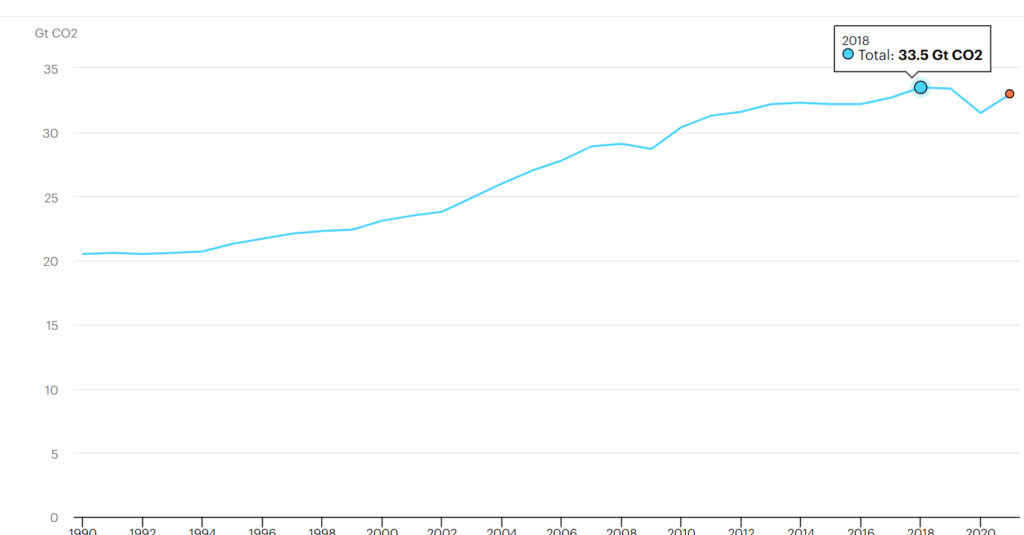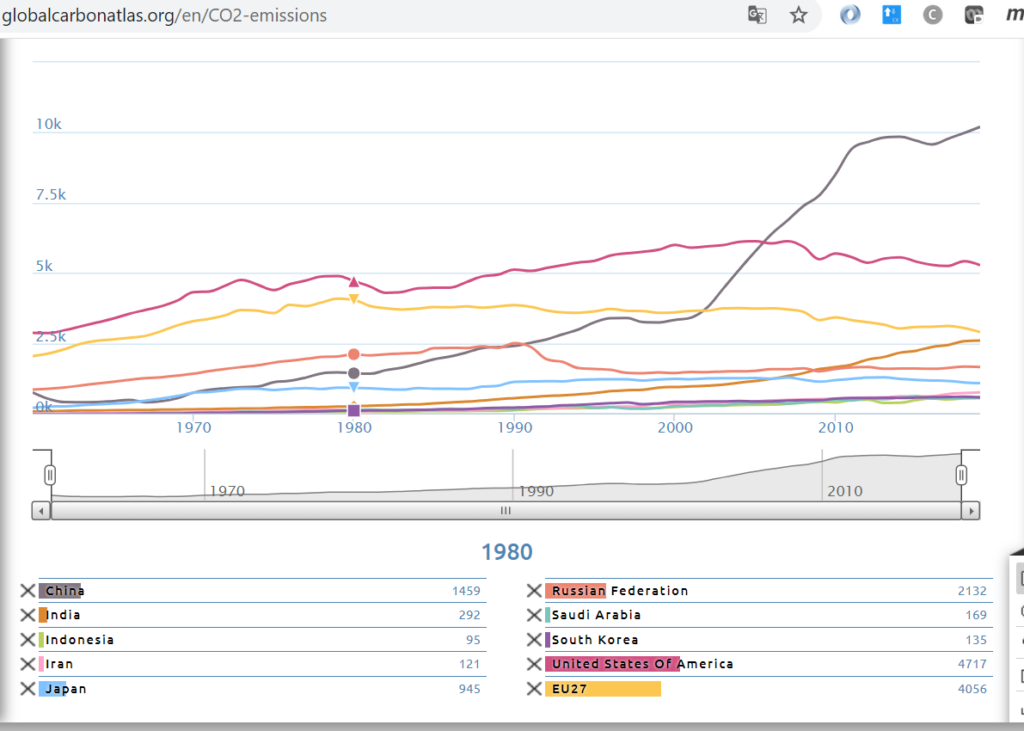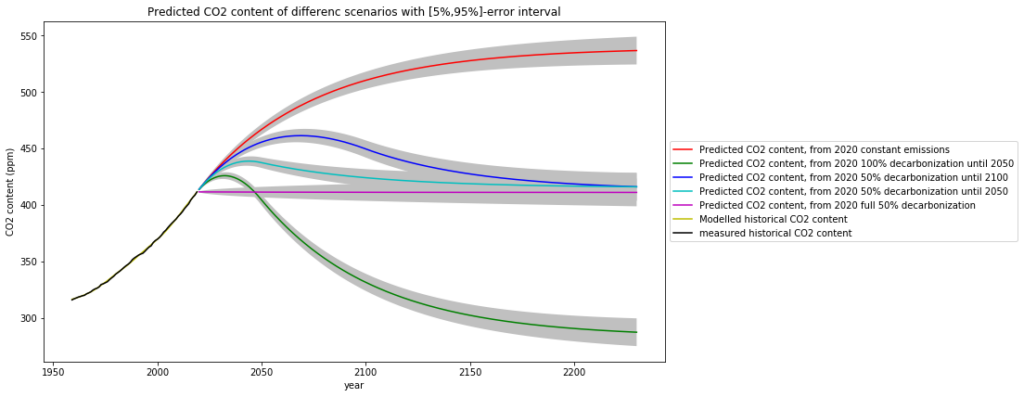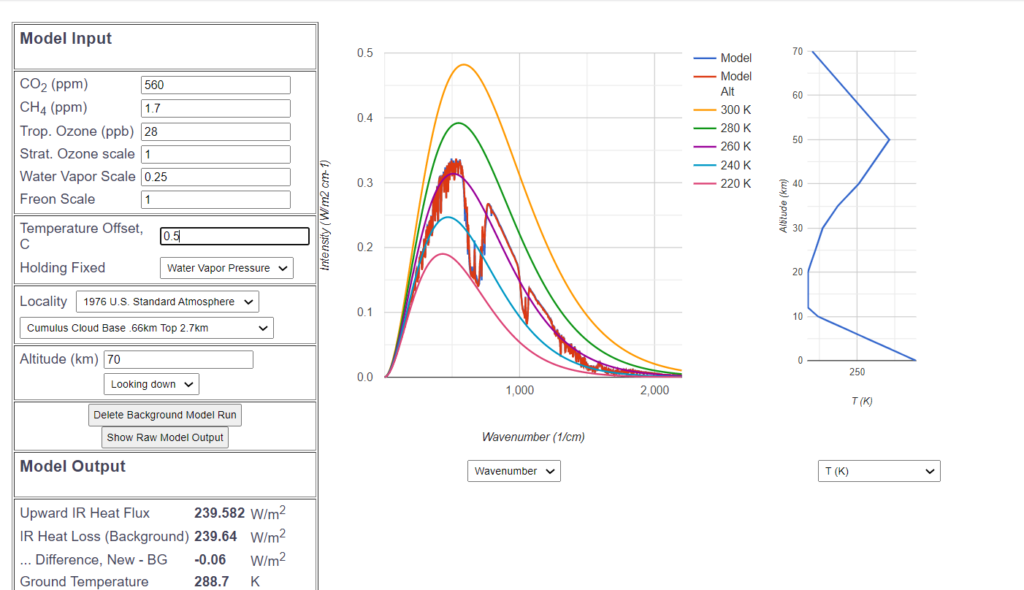1. Global CO2 emissions have reached their maximum level in 2018 and are not expected to increase further
There was a massive drop in emissions in 2020 due to Corona. But the maximum ![]() emissions had already been reached in 2018 at 33.5 Gt, and 2019 and 2021 emissions are below that level as well:
emissions had already been reached in 2018 at 33.5 Gt, and 2019 and 2021 emissions are below that level as well:

Already since 2003, there has been a clear trend of decrease in relative CO2 emissions growth (analogue to economic growth), where between 2018 and 2019, the 0% line was then reached, as described in this article:

The reason for this is that the growth in emissions in emerging economies now roughly balances the decline in emissions in industrialized countries. Also, there has already been a sharp bend in the emission growth in China in 2010.

So the actual “business-as-usual” scenario is not the catastrophic scenario RCP8.5 with exponentially growing emissions that is still widely circulated in the media, but de facto a continuation of global CO2 emissions at the plateau reached since 2018. So the partial target of the Paris climate agreement, “Countries must reach peak emissions as soon as possible“, has already been achieved for the world as a whole since 2018.
2. It is enough to halve emissions to avoid further growth of CO2 levels in the atmosphere
To maintain the current level of CO2 in the atmosphere, it would be sufficient to reduce emissions to half of today’s level (https://www.youtube.com/watch?v=JN3913OI7Fc&t=291s (in German)). The straightforward mathematical derivation and various scenarios (from “business as usual” to “zero carbon energy transition” can be found in this article. Here the result of the predicted CO2 concentration levels:

In the worst case, with future constant emissions, CO2 concentration will be 500 ppm by 2100 and remain below the equlibrium concentration of 544 ppm, which is below double the pre-industrial concentration. The essential point is that in no case will CO2 levels rise to climatically dangerously high levels, but they would probably fall to dangerously low levels if the global energy transition were “successful”, because current peak grain harvests are 15% larger than they were 40 years ago due to increased CO2 levels.
Literally, the Paris climate agreement states in Article 4.1:
Countries must reach peak emissions as soon as possible “so as to achieve a balance between anthropogenic emissions by sources and removals by sinks of greenhouse gases in the second half of this century.”
This means that the balance between anthropogenic emissions and CO2 removals must be achieved in the 2nd half of this century. Fact is that the balance will be reached when total emissions are halved. The time target to reach this 50% goal is between 2050 and 2100, these two limits correspond to the blue and turquoise green scenario. So the Paris climate agreement does not call for complete decarbonization at all, but allows for a smooth transition rather than the disruption implied by the complete decarbonization.
3. According to radiative physics, climate sensitivity is only half a degree
The possible influence of ![]() on global warming is that its absorption of thermal radiation causes that radiation to reach space in a weakened form. The physics of this process is radiative transfer. To actually measure this greenhouse effect, the infrared radiation emitted into space must be measured. The theoretically expected greenhouse effect is so tiny, at 0.2
on global warming is that its absorption of thermal radiation causes that radiation to reach space in a weakened form. The physics of this process is radiative transfer. To actually measure this greenhouse effect, the infrared radiation emitted into space must be measured. The theoretically expected greenhouse effect is so tiny, at 0.2 ![]() per decade, that it is undetectable with current satellite technology, which has a measurement accuracy of about 10
per decade, that it is undetectable with current satellite technology, which has a measurement accuracy of about 10 ![]() .
.
Therefore, one has no choice but to settle for mathematical models of the radiative transfer equation. However, this is not a valid proof for the effectiveness of this greenhouse effect in the real, much more complex atmosphere.
There is a widely accepted simulation program MODTRAN that can be used to simulate the emission of infrared radiation into space, and thus the ![]() greenhouse effect, in a physically clean way. If I use this program to calculate the so-called CO2 sensitivity (the temperature increase when CO2 doubles from 280 to 560 ppm) under correct conditions, the result is a mere 1/2 °C:
greenhouse effect, in a physically clean way. If I use this program to calculate the so-called CO2 sensitivity (the temperature increase when CO2 doubles from 280 to 560 ppm) under correct conditions, the result is a mere 1/2 °C:

The facts are discussed in this article. Also, in order to understand the mindset of IPCC-affiliated scientists, I describe there their, in my opinion, incorrect approach to sensitivity calculations using MODTRAN simulation.
Accordingly, if all real-world conditions are correctly accounted for, the temperature increase from doubling ![]() from 280 ppm to 560 ppm is just 1/2 °C, well below the Paris Climate Agreement targets.
from 280 ppm to 560 ppm is just 1/2 °C, well below the Paris Climate Agreement targets.
4. The only detectable effect of CO2 increase is the greening of the Earth
While the greenhouse effect is so far a theoretical hypothesis, which because of its small effect (less than 0. 2 ![]() in 10 years, which is only a fraction of the measurement errors of infrared satellite measurements (10
in 10 years, which is only a fraction of the measurement errors of infrared satellite measurements (10 ![]() ), so far not provable beyond doubt, another welcome effect of increased
), so far not provable beyond doubt, another welcome effect of increased ![]() content has been abundantly demonstrated: Between 1982 and 2009, the greening of the Earth has increased by 25-50%, 70% of which is due to increases in CO2. Notably, parts of Earth’s drylands have also become greener because plants have a more efficient water balance at higher
content has been abundantly demonstrated: Between 1982 and 2009, the greening of the Earth has increased by 25-50%, 70% of which is due to increases in CO2. Notably, parts of Earth’s drylands have also become greener because plants have a more efficient water balance at higher ![]() levels.
levels.

5. The increase in world mean temperature over the past 40 years has been caused by decreased cloud formation
It is a fact that the mean temperature of the world has increased considerably since 1970. If it is not only due to increased CO2 concentration, what could be the cause?
A simple calculation shows that 80% of the temperature increase over the last 40 years is due to the real and measurable effect of reduced cloud reflectivity, and at most 20% is due to the hypothetical and so far not definitively proven CO2 greenhouse effect:

The causes of reduced cloud formation may indeed be partly man-made, because the basic mechanism of heat regulation by evaporation through plants and the resulting clouds depends on the way humans farm and treat the natural landscape (see also this video (in German)). The most important man-made risk factors are
- deforestation, in particular of rain forests, fatally often with the intention of thereby producing “sustainable” energy,
- urban heat islands due to expansion of large cities,
- expansion of arid lands and desert areas.
All 3 factors contribute to the 5% decrease of average cloud cover since 1950 ( https://taz.de/Wasser-und-Klimaschutz/!5774434/ ), which explains at least 80% of the temperature rise since then as described above.
To stop the warming caused by reduced cloud formation, CO2 emission reductions by stopping use of fossil fuels are of no use. A refocus on solving the real problems instead of ideological fixation on CO2 is overdue.
